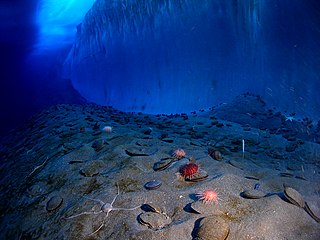
The Ross Sea is a deep bay of the Southern Ocean in Antarctica, between Victoria Land and Marie Byrd Land and within the Ross Embayment, and is the southernmost sea on Earth. It derives its name from the British explorer James Ross who visited this area in 1841. To the west of the sea lies Ross Island and Victoria Land, to the east Roosevelt Island and Edward VII Peninsula in Marie Byrd Land, while the southernmost part is covered by the Ross Ice Shelf, and is about 200 miles (320 km) from the South Pole. Its boundaries and area have been defined by the New Zealand National Institute of Water and Atmospheric Research as having an area of 637,000 square kilometres (246,000 sq mi).

The colossal squid, sometimes called the Antarctic squid or giant cranch squid, is believed to be the largest squid species in terms of mass. It is the only known member of the genus Mesonychoteuthis. It is known from only a few specimens, and current estimates put its maximum size at 12–14 m (39–46 ft) long and weighing possibly up to 750 kilograms (1,650 lb), based on analysis of smaller and immature specimen, making it the largest-known invertebrate.
Belaturricula ergata is a species of sea snail, a marine gastropod mollusk in the family Borsoniidae.
Belaturricula gaini is a species of sea snail, a marine gastropod mollusk in the family Borsoniidae.
Belaturricula turrita is a species of sea snail, a marine gastropod mollusk in the family Borsoniidae.
Nothoadmete delicatula is a species of sea snail, a marine gastropod mollusk in the family Cancellariidae, the nutmeg snails.
Lepetella postapicula is a species of sea snail, a marine gastropod mollusk in the family Lepetellidae.
Belaturricula is a genus of sea snails, marine gastropod mollusks in the family Borsoniidae.

Ophionotus victoriae is a species of brittle star in the order Ophiurida. It has a circumpolar distribution around Antarctica.

Sterechinus neumayeri, the Antarctic sea urchin, is a species of sea urchin in the family Echinidae. It is found living on the seabed in the waters around Antarctica. It has been used as a model organism in the fields of reproductive biology, embryology, ecology, physiology and toxicology.

Glyptonotus antarcticus is a benthic marine isopod crustacean in the suborder Valvifera. It was first described by James Eights in 1852 and the type locality is the South Shetland Islands.
Tropidomarga biangulata is a species of sea snail, a marine gastropod mollusk in the family Turbinidae, the turban snails.
Venustatrochus georgianus is a species of sea snail, a marine gastropod mollusk in the family Calliostomatidae.
Leptocollonia thielei is a species of small sea snail with calcareous opercula, a marine gastropod mollusk in the family Colloniidae.
Anatoma conica is a species of minute sea snail, a marine gastropod mollusk or micromollusk in the family Anatomidae.
Scissurella clathrata is a species of minute sea snail, a marine gastropod mollusk or micromollusk in the family Scissurellidae, the little slit snails.

The wildlife of Antarctica are extremophiles, having to adapt to the dryness, low temperatures, and high exposure common in Antarctica. The extreme weather of the interior contrasts to the relatively mild conditions on the Antarctic Peninsula and the subantarctic islands, which have warmer temperatures and more liquid water. Much of the ocean around the mainland is covered by sea ice. The oceans themselves are a more stable environment for life, both in the water column and on the seabed.
Asthelys semiplicata is a species of extremely small deep water sea snail, a marine gastropod mollusk in the family Seguenziidae.
Eubranchus adarensis is a species of sea slug or nudibranch, a marine gastropod mollusc in the family Eubranchidae. Members of the species are hermaphrodites. The species deposits their eggs on a substratum, where they eventually hatch into a larval stage, ultimately reaching adulthood.

Nerida Gaye Wilson is an invertebrate marine molecular biologist at the Western Australian Museum who has interests in diversity, systematics, phylogeny, phylogeography and behavior. Wilson has been instrumental in demonstrating the level of marine cryptic species complexes in Antarctic waters, testing the circumpolar distribution paradigm with molecular data, and using interdisciplinary approaches to show how Antarctic diversity may have been generated. Her work with NOAA on Antarctic Marine Living Resources has been used to regulate exploratory benthic fisheries.








